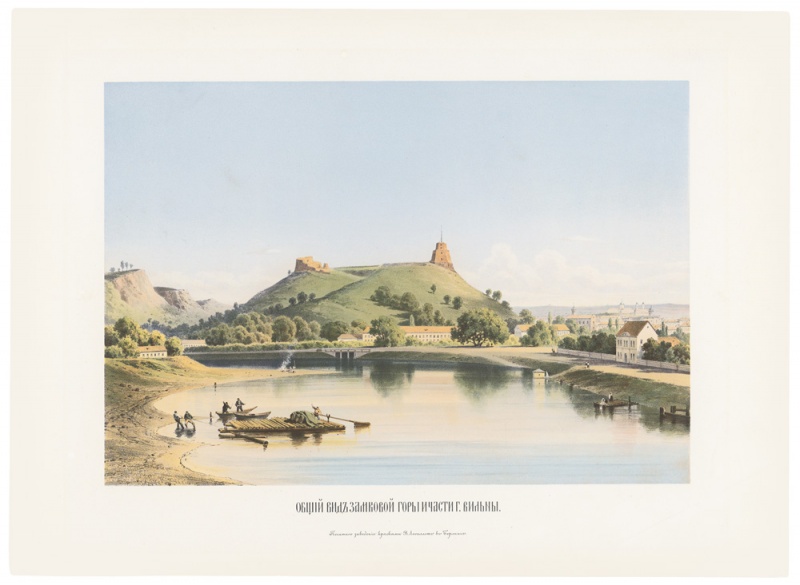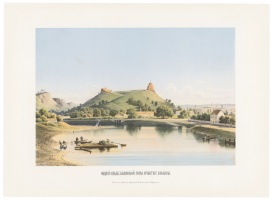
A view of Castle Hill and part of Vilnius
| Authors: |
Ivan Trutnev (?) (1827–1912) Pompei Batyushkov (1811–1892) |
| Created: | 1874 |
| Material: | paper |
| Technique: | chromolithograph |
| Dimensions: | 36 × 47 cm |
| Signature: | inscription: Общий вид замковой горы и части г. Вильны. / Печатное заведение красками В. Лоеиллот в Берлине |
Pompey Batyushkov, ‘Old Russian Monuments in the Western Provinces’, 1874.
The councillor, historian and ethnographer Pompey Batyushkov (1811–1892) studied at an artillery school in St Petersburg. He was appointed vice-governor of Kaunas in 1850, and later became a patron of the Vilnius Educational District and an advisor to the Board of the Ministry of Education of Russia. He was a rigorous supporter of the russification of Lithuania, and promoted the policy of the ‘recovery of Russian origins’. He took an interest in the archaeology, ethnography and history of the Northwest Region (the official name of Lithuania in the Imperial Russian period), and published several books. One of them was the book of chromolithographs Памятники русской старины в западных губерниях (Old Russian Monuments in the Western Provinces). It consisted of eight fascicles, printed in Berlin in 1865, 1874, 1885 and 1886. The drawings for the book were made by local Russian artists: Ivan Trutnev (1827–1912), the head of the Vilnius School of Drawing, and the drawing teacher Vasily Griaznov (1836–1919).
The hill with Gediminas’ Castle was depicted by many artists, but with different implications. For Imperial Russian ideologists, the ruins of the castle pointed to the founding of the city, a period when the Lithuanian rulers were expanding their domains in Slavic lands, forging kinship relations with the Russian nobility, and supporting the Orthodox faith. According to Batyushkov, this was the period of the ‘Lithuanian-Russian state’, which lasted until 1384, when Jagiełło married Jadwiga, and Lithuania joined with Poland and turned towards Catholicism.
Source: Law firm Valiunas Ellex art album VILNIUS. TOPOPHILIA II (2015). Compiler and author Laima LaučkaitėExpositions: “Académie de Vilna. Vilnius Drawing School (1866–1915)”, 5 October – 26 November 2017, National Gallery of Art, Vilnius (curator Jolanta Širkaitė). Published: Académie de Vilna: Vilniaus piešimo mokykla 1866-1915 / Vilnius drawing school: Exhibition Catalogue, Nacionalinė dailės galerija 2017 m. 4 d. - lapkričio 26 d., compiled by Jolanta Širkaitė, Vilnius: Lietuvos kultūros tyrimų institutas, 2017, p. 47. ‘Vilnius Forever. A Dialogue of Artworks and Guides to the City’, 25 May 2022 – 30 April 2023 Lithuanian Art Centre TARTLE (Užupio St. 40, Vilnius). Curator Laima Laučkaitė.







